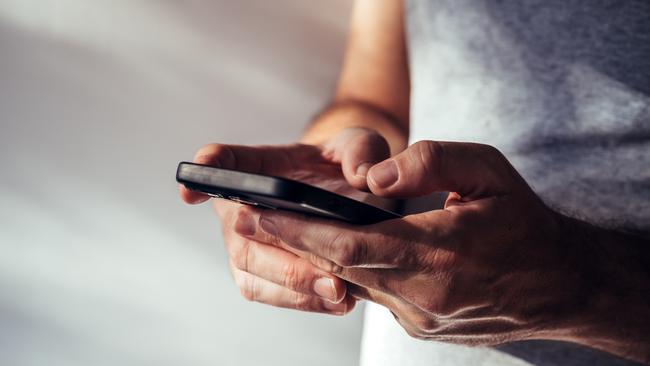Could your mobile phone be carrying Australia’s next biosecurity risk?
A groundbreaking Aussie experiment has uncovered a truly horrifying danger lurking in our mobile phones that nobody can ignore.
Illness
Don't miss out on the headlines from Illness. Followed categories will be added to My News.
Any Australian returning home from an overseas trip knows the drill.
You’re desperate to get out of the airport terminal and onto the final leg of your journey home, but there’s always a chance a Border Force officer will pull you aside for a biosecurity check.
Is that half-eaten jamón sandwich from Barcelona still in your backpack? Will the wooden carving from Fiji make it through customs? Did you clean your shoe after stepping in llama poo in Peru?
Australia’s rigorous border checks are a small inconvenience considering the threat introduced species and pathogens pose to our unique flora, fauna and $90 billion agriculture industry.
But has anyone ever told you to clean your phone before clearing customs? Maybe they should.
Last year, my Bond University research team asked 20 people attending an international medical conference in Sydney to offer up their phones for testing in the name of science.
We wanted to see what pathogens were potentially being brought into Australia, with the phone owners hailing from around the world including North and South America, Europe, Africa, the Middle East, Asia and Oceania.
After swabbing the phones, the samples underwent DNA analysis in a laboratory, revealing a total of 2204 microbes including 882 bacteria, 1229 viruses, 88 fungi and five single-celled protists.
Among them were some nasties: antibiotic-resistant bacteria including Staphylococcus aureus, known for causing infections in hospitals.

Antibiotic resistance is one of the greatest challenges facing healthcare, and globally there were almost 5 million deaths associated with it in 2019. The UN expects that to rise to 10 million deaths in 2050.
Some devices were also hosting threats to plants and animals.
We detected Pantoea stewartii on one international traveller’s phone. This pathogen affects crops and can also cause septicaemia in rare native Australian parrots.
A fungus found on another phone, Fusarium solani, is similar to Fusarium euwallaceae which is associated with the polyphagous shot hole borer, which was first found in Australia three years ago and is spreading in Western Australia.
The borers have a symbiotic relationship with their respective fungi and can kill a tree in two years, raising fears native forests and agricultural crops could be wiped out in Australia.
By extrapolating the results of the study to account for 6.8 million arrivals into Australia between January and October 2022, we estimate 749.2 million microbes may have been introduced to Australia in 2022 via mobile phones.
My previous research has shown our phones are filthy (even 52 per cent of healthcare workers have admitted to using mobile phones in the bathroom).
Average users touch their phones 2617 times a day, and because you also touch your face, surfaces and keyboards, it’s inevitable that germs will find their way onto the surface of your phone.
Almost half of mobile phones tested at the height of the pandemic were contaminated with the SARS-CoV-2 virus, bolstering my theory that the devices supercharged the spread of Covid-19.

Even careful handwashing does not negate the risk without also properly cleaning your phone.
In another study carried out in a paediatric intensive care unit, we found 11,163 microbes on 26 mobile phones, including antibiotic-resistant bacteria.
This poses a significant risk because medical professionals might inadvertently transmit these pathogens to vulnerable patients.
Given that mobile phones cross borders without scrutiny and are highly contaminated, there is a strong case for making phone decontamination part of our biosecurity measures for incoming international travellers.
Whether you’re retuning from overseas or not, there are steps you can take to decontaminate your phone to protect yourself, your family and the country.
The most efficient way is by using UV-C light which kills germs by damaging their DNA. Commercially efficient UV-C phone sanitisers can disinfect a phone in five to 10 seconds.
Apple recommends using a 70 per cent isopropyl alcohol wipe, 75 per cent ethyl alcohol wipe or disinfecting wipes.
Don’t use products containing bleach or hydrogen peroxide and avoid getting moisture in any openings, and don’t submerge your phone in any cleaning agents.
My top tip: stop using your phone in the bathroom or when eating. Our research reveals faecal-derived E.coli are rampant on mobile phones.
Personally, I make sure to clean my phone at least five times a day. It might sound like overkill, but your mobile phone is also a mobile petri dish of bacteria, fungi, viruses and protozoa … all in your pocket.
Dr Lotti Tajouri is an Associate Professor of Biomedical Science at Bond University who works in the field of molecular genetics
Originally published as Could your mobile phone be carrying Australia’s next biosecurity risk?




